Doors
Adjusting Door Strike Plates
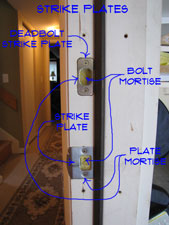
The strike plate receives the door latch and/or deadbolt for your door lock. If they don't line up the lock won't work properly.
If this is not your problem, see 'Door Repair' for all of the Door Repair topics.
Is the Door Adjusted Properly
Many problems with doors and hardware can be solved with some adjustment to the door. Assuming the carpenter installed the door correctly originally, what would cause it not to work now? Age and gravity are the two main things that will affect a door.
Over time, the weight of the door will cause it to sag. When that happens the door strike will not align with the strike plate. Tightening the hinges or adding a support screw may be all that is need to get the door working correctly.
Moving the strike plate should not be needed most of the time. Before you attempt to adjust the strike plate, make sure the door does not need to be adjusted. See 'Adjusting Interior Doors' and 'How To Adjust Exterior Doors' for more information and instructions on how to align the door.
If the door is adjusted properly, there would be two reasons to move the plate. One, the lock is not working right. Two, the door is not tight against the weatherstripping.
Moving a Strike Plate
The strike plate may need to move in or out slightly to allow the strike to seat correctly. Move it away from the center if the strike will not seat when the door is closed.
For an exterior door you want the door to snug up against the weatherstripping. To snug the door up you would move the strike plate toward the center of the door jamb. Move it away from the center if the strike will not seat when the door is closed.
For minor adjustments, you may be able to loosen the plate and tap it in the direction you need.
Use a screwdriver to loosen the screws slightly. Use a block of wood and a hammer to tap the strike plate in the right direction. Hold it in place and tighten the screws.
Chiseling the Mortise
Moving the strike plate any significant amount will involve removing it and chiseling out the mortise. Use the screwdriver and remove the strike plate.
With a sharp pencil draw an outline of where it needs to be on the jamb. With a sharp chisel you can trim out the wood up to the line. Moving the plate slightly will give you a problem with the screw holes.
You might need to whittle a little filler pin and glue it in place. This will give the screws a place to grab in their new location. Otherwise they will want to go back into the old location.
When the glue dries you can trim the pins off with the chisel and install the strike plate. Depending on which way you moved it, you may need to trim the mortise, the one where the strike seats. With the strike plate properly located the door lock should work.
Summary
Did you need to adjust your strike plate, or was it the door out of adjustment? Moving or adjusting a strike plate is not that difficult, hopefully you were able to solve the problem.
Adjusting Doors to Locks
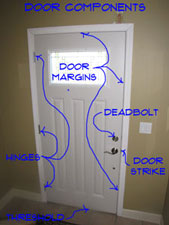 Adjusting doors to locks is needed when the door is out of alignment.The first thing to do is look at the door from the inside when it is closed. There should be an even gap across the top and down the latch side. This gap occurs between the door and the frame or jamb. It should be about an eighth of an inch and be consistent.
Adjusting doors to locks is needed when the door is out of alignment.The first thing to do is look at the door from the inside when it is closed. There should be an even gap across the top and down the latch side. This gap occurs between the door and the frame or jamb. It should be about an eighth of an inch and be consistent.
Some related information can be found in the articles 'How To Fix a Door', 'Fixing Interior Doors' and 'Repairing Exterior Doors'.
If the door is tight against the frame at the top and there is a gap at the bottom, the door is sagging. If the door is hitting the floor, it will still be indicated in the margin along the latch side. Is the gap wider at the bottom and narrower at the top? Yes, then the door is sagging. If the door is sagging you need to make a door lock repair.
Open the door back up and remove the two inner screws for the top hinge. How long are they? An inch or less? This means that the hinge is only being supported by the door jamb itself, not the framing lumber for the wall. Are the screws long, say 2 ½ to 3 inches. That's good, all you will need to do is tighten them up. This door lock repair might be that easy.
If you have long screws, make sure the heads are not stripped. For short screws you need to obtain some 3” number 8 screws. Square or Torx drive are better, but phillips head will work.
Install the long screws, angling them slightly toward the center of the jamb. Snug them up and then check the margins again. Still sagging? Tighten them a quarter turn at a time until the margins are even and the door closes properly.
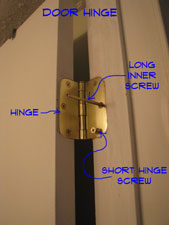 More is not better in this situation. If you over tighten, the door will bind in another direction. Tighten until the margins are even and the door closes easily and then stop. Make sure the strike and the deadbolt are lined up with the mortises and strike plates.
More is not better in this situation. If you over tighten, the door will bind in another direction. Tighten until the margins are even and the door closes easily and then stop. Make sure the strike and the deadbolt are lined up with the mortises and strike plates.
A properly aligned door will allow the lock and deadbolt to work correctly. This was not quite a door lock repair, but it got you to the same place, a working door.
Troubleshooting Door Lock Problems
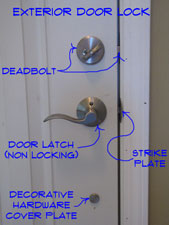 What does troubleshooting door lock problems involve? Before you decide that a door lock is not working, you need to make sure that the door is adjusted properly. If the dood is adjusted, then you can troubleshoot the locks and deadbolts.
What does troubleshooting door lock problems involve? Before you decide that a door lock is not working, you need to make sure that the door is adjusted properly. If the dood is adjusted, then you can troubleshoot the locks and deadbolts.
Not sure if this is your problem? See the article, 'Troubleshooting Door Problems' for a full listing of door problems.
Adjusting the Door
Many times the complaint is about the door hardware. It always seems to be the thing that is not working. Like a medical problem, this is what we call a symtom.
Door hardware only works properly on a door that is aligned the way it should be. The tolerances on doors and hardware is fairly narrow. If a door is sagging, the lock will not latch correctly. Not really the fault of the lock.
Before you consider replacing door hardware, you want to make sure the door is adjusted to allow the hardware to work. See the articles 'Adjusting Exterior Doors' and 'Interior Door Adjustment' for instructions on getting the door in proper alignment.
Troubleshooting Door Lock Issues
Is the key is broken off in the lock?
The Deadbolt is stuck!
Is it difficult to get the latch to engage?
Does the door not stay closed?
This usually indicates that the strike plate needs to be adjusted or the door strike is sticking and needs to be lubricated. The door strike is spring loaded and flat on one side. It needs to spring into the recess in the door strike to keep the door closed.
See the article 'Adjusting Door Strike Plates' for directions on how to fix a poorly aligned strike plate.
The Lock Won't Latch At All
A door that is sagging may cause the door strike to hit the strike plate to low, not allowing it to spring into place. Check the margins on the door. Is the top of the door closer to the jamb on the strike side of the door? If so the door is sagging.
A sagging door needs to be adjusted. See the articles 'Adjusting Exterior Doors' and 'Interior Door Adjustment' for information on how to adjust a door.
The Door Latch is Sticking
When the strike is lined up correctly and still won't keep the door closed you want to make sure it is working. Use your finger to check it. Depress the door strike and let go. It should pop back out freely. If it sticks you need to lubricate it. See the article 'Lubricating Door Locks' for more information.
Does the Door Latch When You Push On It?
If it pops back out freely try putting extra pressure on the door when you close it. Does the strike pop into place when extra pressure is applied to the door? An adjustment to the strike plate will solve the problem. See the article 'Adjusting Door Strike Plates' for directions on how to adjust a strike plate.
The door Knob is Hard to Turn
Is the door knob hard to turn, sticking or hanging up. If the lock has a key, the key may be sticking or not working. Lubricating the lock set will probably take care of it, see Step Four. On rare occasions the lock may be hanging up in the mortises. You can take the knob off and check to see if things are moving freely. By checking the various steps you can make your own door lock repair.
See the article 'Lubricating Door Locks' for more information.
Door Lock Repair
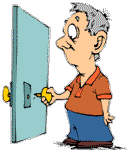 Repairing door locks is a common problem. Sometimes the locks themselves malfunction and need repair or replacement. Other time the door gets out of alignment and the locks won't operate correctly.
Repairing door locks is a common problem. Sometimes the locks themselves malfunction and need repair or replacement. Other time the door gets out of alignment and the locks won't operate correctly.
Not sure if the lock is your problem? See the article 'How To Fix Doors' for a list of all the door repair topics. Some popular lock repair topics are 'Replacing Door Locks', 'Adjusting Door Strike Plates' and 'Lubricating Door Locks'. Follow these links for more information.
Purpose of Door Locks
Door locks and door knobs provide various functions for the door. They give you something to grip while opening or closing the door. They provide varying levels of security. For instance a bedroom door may have a privacy latch that you can open with a bobby pin in a jamb. Your front door may have both a lock and a deadbolt, to keep strangers out.
Door locks have moving parts and therefore, can stop working or not work well. The door lock also aligns with other features on the door, and can not work if the alignment is not good. Door locks also provide an architectural element in the home. It could be that your door lock repair is actually a door lock replacement. There are some things that can be done to repair door locks. Tightening, adjusting and lubricating are simple fixes that can get things working. Read on and learn which door lock repairs you can do yourself.
Door Lock Repair - Information
What Can You Save?
To have someone come out and take care of a door lock for you should cost between $50 and $100. That is assuming that you don't have a more serious problem or the repairman convinces you that you have a serious problem. Getting sold on a new door could cost several hundred dollars. Much cheaper to make your own door lock repair.
How Hard Could It Be?
Door lock repairs are not that difficult and do not require exceptional skill.
For and explanation of the terms in this section, see 'How to Use This Site'.
Check the Simple Things!
The simplest thing with a door lock would be lubrication. Locks that stick or are hard to operate may need to be oiled. Take a look at Step Four, you may be able to save some time. A door lock repair could be that easy.
What Can Go Wrong?
The worst thing that could happen is that you will take a lock that is working poorly and turn it into a lock that does not work. For an exterior door, this could leave you with no way to lock the door. Replacement locks are fairly inexpensive and you could probably get a new one and change it in short order. Temporarily bar the door if it is too late.
Troubleshooting Door Lock Problems
The article 'Troubleshooting Door Lock Problems' discusses what to look for when your lock is malfunctioning. It can be the lock itself or it may be that the door is not aligned properly.
The article 'How To Fix a Door Knob' has information on fixing the door knob itself.
Many times it is not the lock that is the problem. 'Adjusting Interior Doors' and 'Adjusting Exterior Doors' shows you how to align the door so that the door lock works correctly.
'Adjusting Door Strike Plates' is the article that tells you how to move this plate. It may not be neccessary to move the plate if the door is adjusted correctly. See the links above for adjusting doors.
The easiest thing to do with a door lock is to lubricate it. This will solve most problems. 'Lubricating Door Locks' gives you all the information you need.
As a last resort, 'Replacing Door Locks' tells you what you need to know about getting a new lock.
Summary
You probably have many door locks and door knobs in your home. The inner workings of a door lock are usually not practical to try and repair, unless it is a high end commercial lock.
The good news is that even if you can't get your door lock working, a replacement is not that expensive. We hope you were successful with your door lock repair. Now you can move on to other projects or just relax.
Adjusting Door Hinges
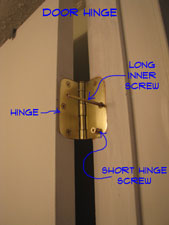 Adjusting door hinges may not be the first fix you would think of when you are having a problem with a door. At first when you look at door hinge, you think that there is no way to adjust them. In a sense, that is true. However, you can change the position of the hinge by using it to adjust the door jamb slightly.
Adjusting door hinges may not be the first fix you would think of when you are having a problem with a door. At first when you look at door hinge, you think that there is no way to adjust them. In a sense, that is true. However, you can change the position of the hinge by using it to adjust the door jamb slightly.
Is this not your problem? See the article 'Fixing and Troubleshooting Doors' for a complete listing of all of the door topics.
How Door Hinges Support the Door
How can you make a door hinge repair when the hinges are sagging and the door will not close? To understand the answer to this question, you need to understand how the hinges support the door.
When a door has three hinges you might think, that each hinge is doing a third of the work. That would be fair, but it is not true. Of the three, the top hinge does the majority of the work. The bottom hinge acts as a fulcrum and the door will tend to sag, pulling at the top hinge.
Problems With Hinges
Top Hinge Issues
A top hinge that only has short screws attached to the frame will start to pull away in time. The frame itself may pull with the hinge. When this happens the door will sag, the top edge of the door on the strike side will start to rub against the frame. This makes the door difficult to close and can leave gaps where daylight comes in.
Door Hinge Mortise Problems
The mortise is the area of wood that is milled or chiseled away to allow the hinge to inset into the door or jamb. Problems can occur when the mortise is too deep or to shallow. This is not common on doors that machined at the factory. It is more common on hinges that are mortised and installed by hand.
A mortise that is too deep can cause the door to have too large a gap against the frame on the strike side. It can also cause the door to bind against the jamb, making it difficult to close. This is a fairly easy problem to fix, you can pack out the hinge with thin cardboard to get the hinge set at the right depth. See the section on 'Packing Out a Hinge' below.
A shallow mortise, will cause the opposite problem. The door might not fit in the opening correctly and may bind against the frame on the strike side. If you have this problem, you can deepen the mortises with a chisel. See the section on 'Mortising a Hinge' below.
Incorrect Hinge Installation
Again, this only occurs with hinges that are altered or installed in the field. Everything about the location of a hinge is important. The size of the hinge needs to be matched to the door, see 'Door Hinge Sizes', both for weight and thickness of the door.
The spacing of the hinges on the door must match the spacing of the hinges on the jamb. There is an inset and a backset for a door hinge. Too much inset/backset and the door will be too tight against the stop and may not close. Too little inset/backset and the door will have gaps at the door stop.
To avoid these types of problems, you should use replacement hinges that are the same size as the old ones. It is not a good idea to try and re-work the mortises to use hinges that are a different size. See the article 'Installing Door Hinges' for more information.
When mortising a new door slab to an existing opening, use extreme caution when locating the hinges. Try to use the old door as a template to get the spacing and backset correct prior to cutting the mortise.
Adjusting Hinges
The key to adjusting door hinges is the top hinge. You need at least one long screw that goes into the wood jamb that holds up the frame. If you are working on an exterior door you want to see the article 'Adjusting Entry Doors' for instructions on how to do this. For interior doors, see the article 'Adjusting Interior Doors'. Both of these articles provide tips on getting the door to set properly in the opening.
Packing a Hinge
To pack out a hinge you can loosen the hinges, (one at a time) and put one or more thin layers of cardboard (this should be dense cardboard, like the kind used for cereal boxes or similar) underneath the hinge.
The effect that the shims will have on the door are somewhat exponential. You do not necessarily need an 1/8" shim to correct an 1/8" gap. It will likely be less than that, depending on where the gap is.
Cut some pieces of thin dense cardboard, slightly smaller than the mortise for the hinge. Try one shim at a time until you get the door aligned the way you want.
Mortising a Hinge
Whoa!! Why do you want to do this. There are a few legitimate reasons, but most of the time this is not needed.
Replacing Hinges
Do not get hinges for replacement that are a different size than the ones that were on the door. If you can't find the right size, go online to find them. See the article 'Door Hinge Sizes' and 'Door Hinge Types' for information on how hinges are sized and how to obtain them. See the article 'Installing and Replacing Door Hinges' for the best practices on replacing hinges.
Getting the mortises right by hand is difficult, so going at your door or jamb with a hammer and chisel is not a great idea.
Replacing a Door Slab
A legitimate reason may be matching a new door slab to an existing opening. For this I recommend getting a door hinge template kit. You can use a regular router and a special bit to cut the mortises. The better kits will have all the templates and accessories you need for whatever hinge size you have.
You can get a kit for around forty dollars. They include the templates that attach to the door or frame, a special router bit, corner mortising chisels if needed and charts on how to locate the hinges.
Summary
The hinges are an important component for any swinging door. When they are out of adjustment, the door will not operate correctly. There are things you can do with the hinges that will get the door aligned properly.


